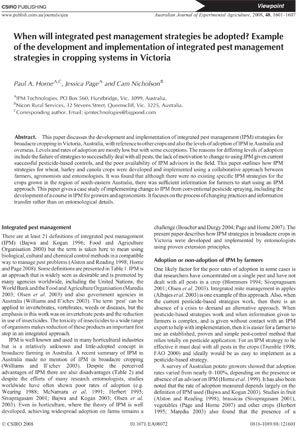|
|
This paper discusses the development and implementation of integrated pest management (IPM) strategies for broadacre cropping in Victoria, Australia. Levels and rates of adoption are mostly low but with some exceptions. The reasons for differing levels of adoption include :
This paper outlines how IPM strategies for wheat, barley and canola crops were developed and implemented using a collaborative approach between farmers, agronomists and entomologists. It was found that although there were no existing specific IPM strategies for the crops grown in the region of south-eastern Australia, there was sufficient information for farmers to start using an IPM approach. This paper gives a case study of implementing change to IPM from conventional pesticide spraying, including the development of a course in IPM for growers and agronomists. The discussion focuses on the process of changing practices and information transfer rather than on entomological details..
Conclusions : The results described here are well founded in the scientific literature and deal with the problem of implementing IPM. The problems are still present but now there are alternative answers present if we want to use them.
After IPM for invertebrate pests has been adopted, there is further opportunity to increase the scope to deal with a range of other pests in a holistic approach. Acknowledgements : We acknowledge the support for IPM provided by Grains Research and Development Corporation for funding of projects IPM00001 and IPM00002. This initial support was developed further by Southern Farming Systems (with particular involvement from former CEO, Col Hacking) and the Grain and Graze program, which allowed rapid extension of on-farm trials and extension support. The commercial demonstrations of IPM in cropping were totally dependant on the individual farmers who agreed to trials on their farms, and in particular Rowan Peel who was the very first. Without the support of Peter OLoughlin and Agvise, the rapid involvement of farmers that we worked with would have been impossible and the collaboration of David Watson of AgVise and Steve Dickson (now at Crop Plus) was essential. The development of an IPM course for farmers and agronomists was made possible by the involvement of Rural Industries Skills Training in Hamilton, Victoria. For the implementation of IPM in a commercial, rather than research, environment we acknowledge the tireless efforts of Neil Hives. Finally, we would like to thank Drs Chris Anderson and Paul Umina for their support with the preparation of this paper, and Anna Cutler and Janet Horne for comments on the final manuscript. |
|

